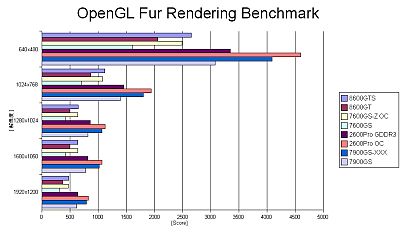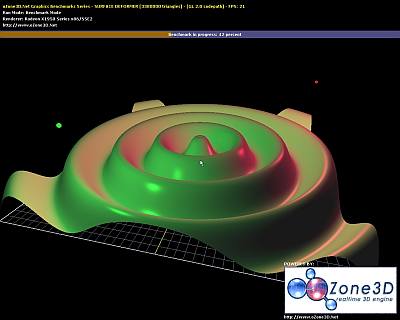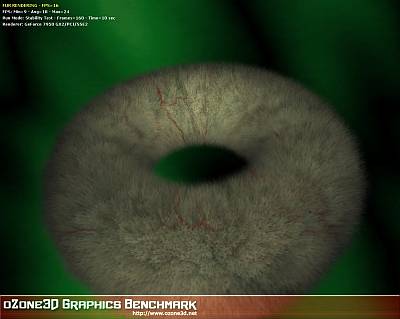I found this video about FluidMark:
[youtube 9qnX7d-S1l0]
It’s true, FluidMark is really boring. I’ll try to do better for the next benchmarks 😉
News en vrac / WP sandbox
I found this video about FluidMark:
Je suis tombé sur ce fil de discussion chez [H]ard|Forum où l’on peut lire ceci:
“That fur demo is known to get cards the hottest, it is also known for smoking cards as well (it was the last thing run for a number of people on the extremesystems forums).”
En gros ça dit que le FurMark est connnu pour faire le plus chauffer les cartes mais qu’il aussi connu pour les faire fumer et c’est souvent la dernière chose que certains utilisateurs aient vu! Je savais que le FurMark était bon pour faire chauffer les cartes mais je ne savais pas qu’il était aussi capable de les détruire. Je sens que cet été va être chaud pour certaines cartes graphiques…
Le site www.hardware.info propose une compétition d’overclocking de GPU et utilise le Fur Rendering Benchmark comme utilitaire principal (bon c’est ma version des faits vu que tout est écrit en néerlandais mais je ne dois pas me tromper de beaucoup – si quelqu’un comprend cette langue, merci d’avance pour un petit feedback de ce qui s’y raconte). Décidément, le fur benchmark fait parler de lui ces derniers temps. Mais le truc marrant c’est que tout le monde s’obstine à utiliser la version 1.0.0 alors que la version 1.1.0 existe…

Funny, my furry benchmark has been used in a graphics card review along with 3DMark or Lost Planet. Pretty cool 😉

From oZone3D.Net Forums, the Catalyst 7.9 seems to unleash ATI Radeon 2900 GPU. The Surface Deformer benchmark is a benchmark that requires a lot of vertex processing horse power. With Catalyst prior to 7.9, the score of an ATI 2900 was around 8000 o3Marks (that was already high). Now with Catalyst 7.9, the 2900 gets a score of 15000 o3Marks. Incredible!!! Why such a big big jump in OpenGL performance ?
My first thought is that ATI has managed to use correctly the unified arch of the R600 gpu. With unified arch, the workload is distribued over all shaders processors no matter the type of the shader prog (vertex or pixel). So if the vertex shader needs more processing power than the pixel shader, more shaders processors will be used for the vertex shader. My second thought: unified arch has involved new kernel code for catalyst and simply ATI has optimized the R600 codepath. A driver for a modern GPU like the R600 is a very complex piece of code and optimizing such a code is a huge task….

I officially released the fur rendering benchmark 4 days ago. So let’s analyze a little bit the first feedbacks available on forums over the web.

Homepage: www.ozone3d.net/benchmarks/fur/
1 – Fur rendering benchmark isn’t cpu dependent and this is a very good thing for a graphics card benchmark. No matter the cpu speed, the result for a given card stays equivalent:
– oZone3D.Net forums
– extremeoverclocking.com forums
– extremeoverclocking.com forums
“yes the first propper gpu bench ive come across, i really like this…. it stops all the arguments about memory timings and cpu speeds. its a good equaliser as all our systems can provide that 10% cpu info the gpu needs…”
2 – 8800GTX vs 2900XT
ATI 2900XT seems to beat NVIDIA 8800GTX. In all forums, the 2900XT is ahead:
– oZone3D.Net forums
– overclockers.co.uk forums
– extremeoverclocking.com forums
3 – this benchmark seems to nicely overload the graphics card and then is a cool GPU burner and stress/stability test utility.
– clubic.com forums : “Par contre j ai jamais vu ma carte graphique chauffer autant: environ 100° pendant la test:ouch:”
– oZone3D.Net forums: “This thing just succeeded to shut down twice the PSU, caused by overloading of the graphics board!!”
I done a little test with my 8800GTX:
– gpu core temp at rest: 58°C
– gpu core temp at load: 83°C

Okay, that’s all for that small benchmark. :winkhappy:
Several weeks ago, I posted on Beyond3D a thread on my dynamic branching benchmark. I wondered why dynamic branching performances on Geforce 7 were worse than ones on Geforce 6 or 8. I believe I’ve got the answer: Forceware drivers.
Here are some new results where ratio = Branching_ON / Branching_OFF :
7600GS – Fw 84.21 – Branching OFF: 496 o3Marks – Branching ON: 773 o3Marks – Ratio = 1.5
7600GS – Fw 91.31 – Branching OFF: 509 o3Marks – Branching ON: 850 o3Marks – Ratio = 1.6
7600GS – Fw 91.36 – Branching OFF: 508 o3Marks – Branching ON: 850 o3Marks – Ratio = 1.6
7600GS – Fw 91.37 – Branching OFF: 509 o3Marks – Branching ON: 850 o3Marks – Ratio = 1.6
7600GS – Fw 91.45 – Branching OFF: 509 o3Marks – Branching ON: 472 o3Marks – Ratio = 0.9
7600GS – Fw 91.47 – Branching OFF: 509 o3Marks – Branching ON: 472 o3Marks – Ratio = 0.9
7600GS – Fw 93.71 – Branching OFF: 508 o3Marks – Branching ON: 474 o3Marks – Ratio = 0.9
7600GS – Fw 97.92 – Branching OFF: 505 o3Marks – Branching ON: 478 o3Marks – Ratio = 0.9
7600GS – Fw 100.95 – Branching OFF: 508 o3Marks – Branching ON: 480 o3Marks – Ratio = 0.9
my conclusion is: dynamic branching in OpenGL works fine (read the performance are better than without dynamic branching: ratio > 1) for forceware < = 91.37. For the drivers >= 91.45, the ratio drops under 1. Dynamic branching works as expected for gf6 and gf8 but not for gf7 since forceware 91.45. So the bug explanation is a plausible answer (and it’s easily understandable: in this news we learnt that a forceware driver is made of around 20 millions of lines of code – a paradise for a small bug!!!). I’ve also done the test with the simple soft shadows demo provided with the NV SDK 9.5. The results are the same.
I’ve just done the bench with a 7950gx2 and the latest forceware 160.02 and dynamic branching is still buggy…
I must confess the SLI is a really cool technology. I assembled a SLI station based on the new nVidia Geforce 7600 GS series. This is a little graphic card compared to the high-end ones like the 7900GTX or the big monster 7950 GX2 (which in passing is really quiet in spite of its two GPUs and ventirads): the price of a 7600GS is about 100 euros, the price of a 7900GTX is about 400 euros and the cost of the 7950 GX2 climbs up to 500 euros! In terms of shader pipelines, the 7600 GS has 5 vertex pipes and 12 pixel pipes, the 7900 GTX has 8 vertex pipes / 24 pixel pipes and the GX2 has 48 pixel pipes and 16 vertex pipes. And so what? A 7600 GS SLI system offers almost the same level of gpu power than a 7800/7900 for a half price. I’ve verified this fact with the latest version of the soft shadows benchmark. With one 7600 GS (single GPU mode) the score is 510 o3Marks. With the two 7600 GS in SLI mode, the score jumps to 1004 o3Marks. The 7950 GX2’s score in single GPU is about 1200 o3Marks. Ok my bench is a small bench, you’re right. What about 3dmrk06? The 3DMark06 score is 4115 for the 7600 GS SLI system. This score is close to the ones got with a non-overclocked gf7800/7900.
Little remark: my 7600 GS are not overclocked.
Conlusion: for 200 euros you can have an excellent graphic system which is also silent thanks to the 7600GS passive cooler!


I’ve just finihed to implement soft-shadows in the new oZone3D Engine. And I must say that soft shadows bring a huge amount of realism and credibility to 3d scenes. See for yourself:

The oZone3D tech demo is available here: Soft Shadows Demo
You can consider this demo as a little benchmark. Just start the oZone3D_SoftShadows_Benchmark.exe and look at the FPS in the title bar. With my current devstation I got the following score:
PC1: AMD64 3500+ / 1024M DDR400 / Radeon X700Pro 128M Catalyst 6.6 / WinXpsp2: 5 FPS :thumbdown:
Soft shadows are very GPU consuming but they are the future of 3D! So to make the most of soft shadows, update your graphics card!